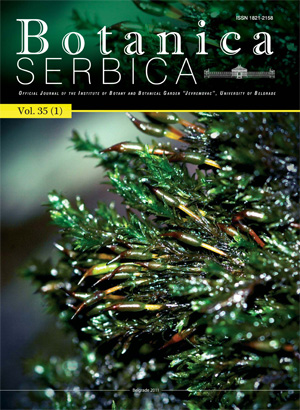
Volume 35 Issue 1 2011 |
Structural and ultrastructural characteristics of Rhodophyta from the Romanian Black Sea coast |
KEY WORDS: Polysiphonia denudata, Ceramium rubrum, Callithamnion corymbosum, Phyllophora nervosa, Porphyra leucosticta. |
The Cinclidotus P. Beauv./Dialytrichia (Schimp.) Limpr. complex (Bryopsida, Pottiaceae) in Turkey |
KEY WORDS: Hygrophytes, identifi cation key, mosses, phytogeography, plant anatomy, plant morphology, speciation centre |
Induction of bulblets on leaf and bulb explants of endangered Lilium bosniacum (G. Beck) G. Beck ex Fritsch |
KEY WORDS: Regeneration, Lilum bosniacum, bulb and leaves explants |
Ecology and distribution of red macrophytic algae from the Romanian Black Sea coast |
KEY WORDS: Romanian Black Sea coast, macrophytobenthos, red algae, Rhodophyta |
Screening of plant extracts for antioxidant properties |
KEY WORDS: antioxidant, DPPH, plant species |
Caffeine induced genotoxic effects in Phaseolus vulgaris L. and Raphanus sativus L. |
KEY WORDS: caffeine, chromosome aberrations, genotoxicity, Phaseolus vulgaris, Raphanus sativus |
Rumex confertus (Polygonaceae) in the Bulgarian flora |
KEY WORDS: Bulgarian flora, chorology, chromosome number, map, Rumex confertus, morphology. |
In vitro conservation of micro-propagated Ruscus aculeatus L. (Liliaceae) plants |
KEY WORDS: Ruscus aculeatus, conservation, thidiazuron, micropropagation |
Salidroside content in Rhodiola rosea L., dynamics and variability |
KEY WORDS: Rhodiola rosea L., salidroside, variation, dynamics. |
Axenically culturing the bryophytes: establishment and propagation of the moss Hypnum |
KEY WORDS: moss, Hypnum cupressiforme, in vitro, development, propagation |


